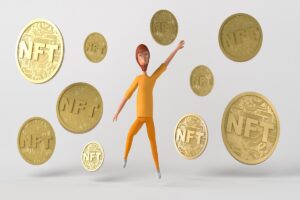NFTs are a new form of tradeable asset that generates value over time, giving birth to a new market that goes against the conventions of trade and finance. They have made headlines, been used by large brands, and embraced by celebrities all over the world.
While it’s fair to say that NFTs may not replace the market as we know it, to dismiss them as a temporary phase would be a missed opportunity – one that translates to a potential loss in profit for businesses. If you’re an entrepreneur looking to capitalize on the rapidly-growing industry of NFTs – a market that sees hundreds of millions of dollars transferred every week – here are a few considerations you might want to keep before diving into the high-risk, high-return field:
1. Understanding an NFT
Before you start, you must understand the basics of NFTs. First of all, NFTs are not cryptocurrencies. Bitcoin, Ether, Ripple, and other cryptocurrencies are called fungible tokens. In simple terms, they are mutually interchangeable. A bitcoin can be traded into another form of cryptocurrency with an equivalent value. Prices change, but it can be traded for the same value.
On the other hand, non-fungible tokens do not function the same way. Their value is worth as much as you want it to be, as there are no restrictions on pricing. Imagine an artwork whose value might be assessed by experts or be set by the artist himself. In the digital world, and NFT may be an image, video, music, or a digital item inside a game or a program. They can be traded into cryptocurrency, although their value is not defined by previous purchases or their supply available in the market.
Also, it’s important to understand that what makes the NFT unique isn’t the art form seen by the naked eye. These are the pieces of code embedded in these files that make it unique, immutable, and virtually unstealable. So when you see people cropping or grabbing the image of your NFT on the internet, don’t fret. It’s the same as taking a picture of a painting; you still have the master copy.
2. The Market is Illiquid
As mentioned earlier, what makes the NFT market enticing to entrepreneurs, artists, and creators is that they can sell their wares at a price they think they deserve. In the traditional market, there are a lot of buyers and sellers, and transactions are often standardized, which leads to prices being dictated and regulated. An illiquid market, on the other hand, is one where buyers and sellers are few and far in between. This is seen with the NFT market with its relatively lower trading volume and greater price volatility.
This means that while you’re free to sell your goods at the price you want to, you have to find a buyer willing to meet you at that price. Be careful in generating your NFT items: you wouldn’t want to invest a hefty sum for the design, plus the minting costs, only to leave your item in the marketplace collecting dust. Minting refers to the digital process of converting your digital file – whether it’s a photo, video, music, or any other digital asset – into a non-fungible token. Depending on the platform, you may have to pay a certain fee in cryptocurrency in order to mint your item and post it for sale.
It also leads to the next problem with an illiquid market, volatility. Everything changes a lot faster, as a Bitcoin may change the value in a span of an hour or less. This affects everything from your minting cost, transfer fees, or gas, as well as the very price of your NFT.
3. Risks of Ownership and Fraud
Remember when we said that what makes NFT unique are the pieces of code embedded into it? That serves as its record on the blockchain, which is like a digital ledger that logs all transactions and locations of the NFT. This means that the NFT we see is different from the digital record embedded in it. Think of the artwork and the digital ID card kept somewhere else.
Now, the risk comes from NFTs which are hosted privately by companies or tech startups that hand them out. Once their companies go under, they might lose all files they host. This means that all the users who received NFTs from them will retain the records of their ownership. However, these tokens will be linked to files that don’t exist anymore. Until all NFTs are hosted on decentralized, cloud-based services, this is a risk worth noting.
Also, while it’s virtually impossible to forge an NFT or replicate an existing one, it doesn’t mean that the market is free from fraud. There are cases where people grab the file from an existing NFT, mint it as their own, and sell it to those who are unaware. For example, grab a high-resolution image of the record-setting Everydays: The First 5000 Days, originally by Beeple and sold for $69 million. You can upload it to an NFT marketplace, mint it as your own, and sell it. There are other forms of fraud that exist in the market, and you’ll have to do your homework to keep yourself safe from them.
Author
-

NFT connoisseur with a profound appreciation for digital creativity and its marketplace dynamics.




